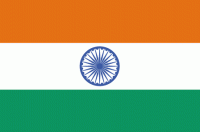India – climate and energy statistics
Posted in National and regional statistics on 05/28/2009 05:34 pm by Stephen Tindale Total national greenhouse gas emissions
Total national greenhouse gas emissions
Approximately 5% of the global total. This puts India fourth, behind the US, China and Russia.
Historical contribution 1850 to 2000
2%
Per capita greenhouse gas emissions
1.8 tonnes. (The US is at 23.5 tonnes, most European countries at around 10 tonnes.)
Energy used per unit of GDP (compared to USA)
86%
Balance of energy sources – 2008
| % | |
| Coal | 42 |
| Renewables* | 26.5 |
| Oil | 23.25 |
| Gas | 5.75 |
| Hydro | 1.5 |
| Nuclear | 0.6 |
* predominantly biomass gathered and used in rural areas, so non-commercial use.
Energy security
India has 10% of the world’s proven coal reserves – placing it fourth, behind the US (27%), Russia (17%) and China (13%). It also has gas resources for about the next 30 years. Its current gas use is two-thirds from Indian gas fields and one third imported. The western offshore region, especially fields near Mumbai, produces most Indian gas, although the Bay of Bengal is also significant.
India has the twentieth largest proven oil reserves in the world. However, they are expected to run out by 2016. A third of the oil currently used in India is imported.
Electricity generated in 2008
| Fuel | % |
| Coal | 68.5 |
| Hydro | 13.75 |
| Gas | 10 |
| Oil | 4 |
| Nuclear | 1.75 |
| Wind | 1.65 |
| Biomass | 0.25 |
Installed wind capicity
- 2002 1.7Gw
- 2003 2Gw
- 2004 3Gw
- 2005 4.5Gw
- 2006 6.2Gw
- 2007 7.9Gw
- 2008 9.6Gw
- 2009 10.9 Gw
Electricity – supply and demand
80% of Indians do not get electricity from the grid.
One-third of Indian businesses say that unreliable electricity is one of the main obstacles to success.
The Indian grid is connected to the grids in Nepal and Bhutan. This has allowed these countries to export surplus electricity to India.
Fuels used for heating, cooking and cooling
The International Energy Agency does not publish statistics about heat use in India. Natural gas is not available to households for heating or cooking – three-quarters of the gas used in India is for electricity generation or the manufacture of fertilisers. Liquified Petroleum Gas (LPG) is available, and is increasing rapidly, though too expensive for many Indian householders. The use of electricity for air conditioning, cooking and heating is also increasing rapidly.
Percentage of agriculture certified as organic, 2006
0.06% (although much more is organic in practice, but not certified as such).
Cars per thousand people
12 (compared to 765 in the USA).

